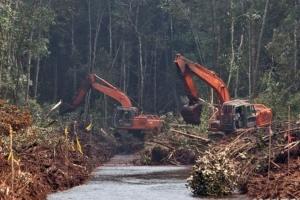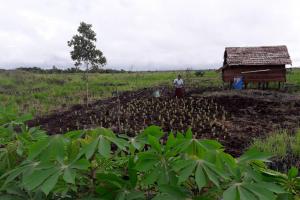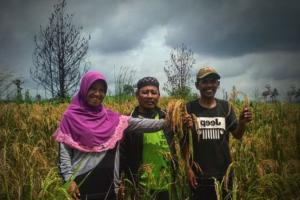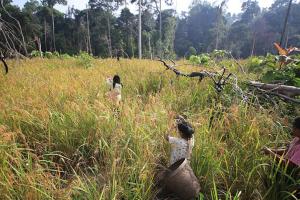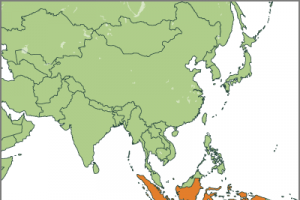Several banks and other financial institutions around the world have been warned on last 6 November to avoid investments in pulp and paper mills associated with deforestation and human rights abuses in Indonesia.
Sixty environmental and social non-governmental organisations, including a dozen Indonesian civil society groups, have sent letters asking for assurances that the financial institutions will not invest in increased pulp milling capacity by Asia Pulp and Paper (APP) or other companies associated with the Sinar Mas Group until reforms have been achieved.
Indonesia
Other information
14 December 2012
Bulletin articles
14 December 2012
Article based on a field visit and conversations with villagers in 5 of the 7 most affected communities by this project.
Bulletin articles
30 October 2012
About 40 farmers of a La Via Campesina member organization (Serikat Petani Indonesia) from Jambi province protested in front of the Germany Embassy on October 16 against the negative impacts of a Debt Nature Swap (DNS), signed in 2007 between the German Government and Indonesian authorities. The objective of the agreement to protect tropical forests in Sumatra led in practice to the eviction, burning of houses and arresting of farmers who have lived long in the area.
Source: http://www.metrojambi.com/v1/metro/11013-puluhan-petani-merangin-demo-kedutaan-jerman.html
Bulletin articles
30 October 2012
The state administrative High Court in Medan, has decided in favor of the organization WALHI, cancelling administrative decisions that led to the issuance of the license to the oil palm plantation PT Kalista Alam for an area of around 1,605 hectares in the Rawa Tripa peat swamp forest, Nagan Raya District, Aceh.
Bulletin articles
30 October 2012
The struggle in Geragai District
Up to 2011, a total of 18 companies had licenses over forest areas for a total of 663,809 ha distributed over 8 Regencies in Jambi Province, Sumatra, nearly 50% of which - 293,812 ha - is being controlled by one large corporation, PT. WiraKaryaSakti (PT. WKS), a subsidiary of Sinar Mas Group. The concession land of PT. WKS is divided in 5 Regencies, namely Tebo Regency, Batanghari Regency, Muaro Jambi Regency, TanjungJabung Barat Regency, and TanjungJabungTimur Regency.
Bulletin articles
30 September 2012
Timber Plantation concessions are a model of forest exploitation conducted by corporations in Indonesia. More than 9 million hectares of timber plantation concessions have already been awarded by the Ministry of Forestry, though not all of these concessions are used for timber plantations. Up to 2011, less than half of the total area of timber plantation licenses was being managed by the license holder corporation.
Publications
11 June 2012
After many years of supporting local struggles and disseminating information from different countries on tree monocultures and its impacts, WRM presents a new report to all those involved in these struggle.
Bulletin articles
30 May 2012
The International Labour Organization (ILO) is the UN agency that oversees labour issues, shaping policies and programmes mainly related to labour standards for the protection of workers.
Bulletin articles
30 April 2012
How far would you go to protect your forest?
Villagers from Pollo community in South Central Timor regency in Indonesia have set a remarkable example, weathering years of bureaucratic indifference, enduring violence from thugs and embarking on an odyssey across their country's archipelago in search of support for their defence of local trees and land.
Other information
29 January 2012
The Indonesian police attacked a peaceful demonstration in SAPE Harbor on December 24, 2011, killing three persons and injuring at least twenty-nine others.
The protestors were members of Anti-Mining People's Front (FRAT) and were demanding against the Bima Gold Mine Project, owned by Australian PT. Arc Exploration Ltd.. The undertaking will dismantle the agricultural lands and disrupt water resources with very harmful consequences on the environment and the lives of local people who are mainly fisherpersons and farmers.
Bulletin articles
30 December 2011
A new report published in November 2011, exposes how local police in the Province of Jambi on the Indonesian island of Sumatra, working with oil palm plantation staff, systematically evicted people from three settlements, firing guns to scare them off and then using heavy machinery to destroy their dwellings and bulldoze concrete floors into the nearby creeks. The operations were carried out over a week in mid-August and have already sparked an international controversy. Andiko, Executive Director of the Indonesian community rights NGO, HuMa said:
